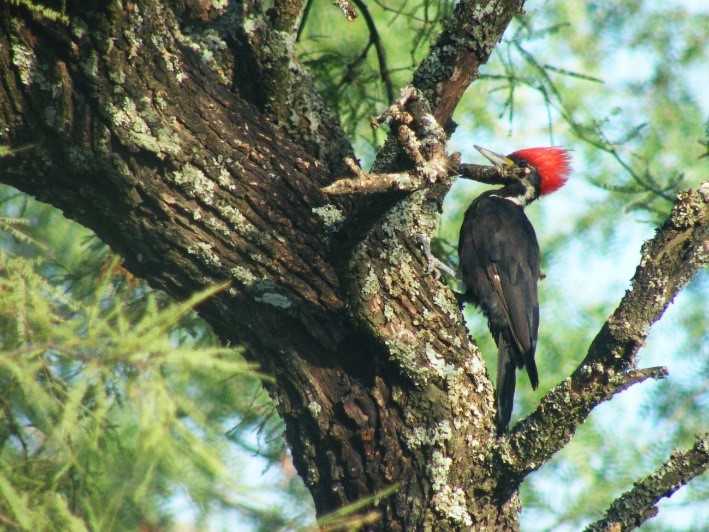When landscapes change, conservation strategies must change as well
CONICET, INTA and Humboldt-Universität zu Berlin press release.
New research published in Journal of Applied Ecology explores the complex ways agriculture impacts biodiversity. Looking at Gran Chaco, a global deforestation hotspot, researchers find that trade-offs between agriculture and biodiversity change when the landscape changes, with species responding differently to the same level of agricultural intensity, depending on how much forest is left.

Agriculture provides societies with food and biomass, but where agriculture expands into tropical and subtropical forests, biodiversity losses can be large. Understanding how exactly agriculture impacts biodiversity is therefore critically important for helping farmers and planners to find ways to avoid biodiversity losses.
New research shows that this can be much trickier than thought: how biodiversity responds to intensifying agriculture very much depends on the type of landscape – and landscapes can change drastically as deforestation progresses. This means that conservation strategies must be flexible as well to avoid failing.
Forests in the Global South continue to disappear rapidly in many regions as agriculture expands into them – and trend happening mainly due to the growing demand for agricultural commodities like soybean, palmoil or beef. Increasing the protection of forests and their biodiversity is therefore critically important. Finding conservation strategies that work, however, first requires answering the question of how biodiversity actually responds to expanding and intensifying agriculture.
A new study by researchers from CONICET and INTA (Argentina) and Humboldt-Universität zu Berlin (Germany) sheds new light on this question. The team focused on the Gran Chaco, a global deforestation hotspot, and assembled a large datasets of birds and agricultural intensity to analyze how bird communities change as land-use change happens.
“Our most important finding is that the trade-offs between agriculture and biodiversity change when the landscape changes”, Dr. Leandro Macchi (CONICET & HU Berlin) lead-author of the study explains.
In other words, species respond differently to the same level of agricultural intensity, depending on how much forest is left.
This was a surprising finding, because previous studies had analyzed these trade-offs only at one point in time, and then assumed that trade-offs remain constant over time. Instead, the researchers found many bird species to switch in their fundamental response to agriculture as landscapes were transformed.
“Some bird species even benefitted from increasing agricultural intensity, and we call such species winners” Dr. Julieta Decarre from INTA highlights. “Yet, many of these species were only winners in landscapes that still contain a lot of forest but became losers as deforestation progressed. Eventually, these species then disappear from the landscape.”
This finding has far-reaching consequences for farmers and planners. How to design landscapes that mitigate trade-offs between agriculture and biodiversity is a big question. Some have argued that intensive agriculture and wild areas should best be separated, a land-use strategy called land sparing, while others have argued for integrating the two in agro-ecological landscapes, a strategy called land sharing.
“Our results clearly show that any of these strategies can fail if we do not consider that biodiversity might react very differently to the same form of agriculture in landscapes with much or little remaining forest” Tobias Kuemmerle (HU Berlin), senior author of the study explains. “This means we need to constantly monitor how biodiversity reacts as landscapes change – and be ready to change our conservation approach.”
The Chaco is such a landscape – and one of the ecosystems disappearing most readily across the globe. The area is very rich in biodiversity, with many species only occurring there, but the Chaco is also very weakly protected. “This is symptomatic for many tropical and subtropical regions,” Dr. Decarre remarks “these regions are often overlooked, and are in critical need of land-use and conservation planning.”
The authors conclude that an adaptive strategy is needed to manage trade-offs between agriculture and biodiversity. Rather than identifying a fixed land-use strategy, understanding which mixes of land systems align agriculture and biodiversity best at broader scales, now and under future conditions, should be key goals for scientists and decision makers.
You can read the article for free (for a limited time) here:
, , , et al. Trade‐offs between biodiversity and agriculture are moving targets in dynamic landscapes. J Appl Ecol. 2020; 00: 1– 10. https://doi.org/10.1111/1365‐2664.13699
Media contact:
Dr. Leandro Macchi, Instituto de Ecología Regional, UNT – CONICET, Argentina
Email: leandromacchi@gmail.com , Phone +54 381 4255174
(GMT-3)
Dr. Julieta Decarre, Instituto de Recursos Biológicos (IRB-CIRN), Instituto Nacional de Tecnología Agropecuaria (INTA), Argentina
Email: decarre.julieta@inta.gob.ar, Phone: +54 11 58303203
(GMT-3) [English & Spanish]
Professor Dr. Tobias Kümmerle, Humboldt-Universität zu Berlin, Germany
Email: tobias.kuemmerle@hu-berlin.de, Phone: +49 30 2093 9372
(GMT+1) [English & German]
Like what we stand for?
Support our mission and help develop the next generation of ecologists by donating to the British Ecological Society.